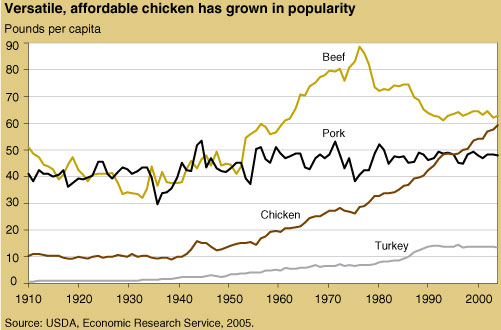Chicken Consumption Continues Longrun Rise
- by Jean C. Buzby and Hodan Farah Wells
- 4/1/2006
Is chicken on your menu today? Perhaps in an enchilada or a stir fry made at home, or chicken tenders at a restaurant tonight? If so, you will have plenty of company. Chicken consumption more than doubled between 1970 and 2004, from 27.4 pounds per person to 59.2 pounds (boneless, edible weight). Chicken is gaining ground on beef, the current leading meat.
Chicken consumption has climbed since the 1940s, according to ERS’s per capita food availability data, a widely used proxy for actual food intake. Food availability data go back to 1909 for many commodities and include all food—from grocery stores, restaurants, school cafeterias, and other eating places.
Part of the rise in chicken consumption results from the chicken industry’s response to demands by consumers and foodservice operators for value-added, brand-name, and convenience products. McDonald’s Chicken McNuggets revolutionized chicken as both a convenience and a frozen food in the early 1980s. According to the National Chicken Council, 42 percent of chicken is now sold through foodservice outlets. Of this amount, 60 percent is sold through fast-food chains, which have introduced new lines of chicken sandwiches, salads, wraps, and tenders to meet the rising demand for chicken.
Grocery stores typically stock boneless, skinless breasts; rotisserie-cooked whole chickens; and seasoned chicken parts—all value-added products for convenience-minded shoppers. Chicken consumption has also benefited from health-related concerns about beef. Ounce for ounce, chicken has less total fat, saturated fat, and cholesterol than beef, according to USDA’s 2005 nutrient database.
Innovations in breeding, mass production, contract farming, vertical integration, and marketing have made chicken more plentiful and affordable. The average live weight per broiler nearly doubled to 5.35 pounds from 1934 to 2004, and it reaches that weight in less time. These supply-side changes and the expansion of the broiler industry have lowered per unit production costs. As a result, the “composite” price (whole bird, breast, and leg prices, weighted by estimated quantities purchased) in 2004 dollars for a pound of chicken was $1.74 in 2004, versus $2.22 in 1980.
You may also like:
- Food Availability (Per Capita) Data System. (n.d.). U.S. Department of Agriculture, Economic Research Service.


